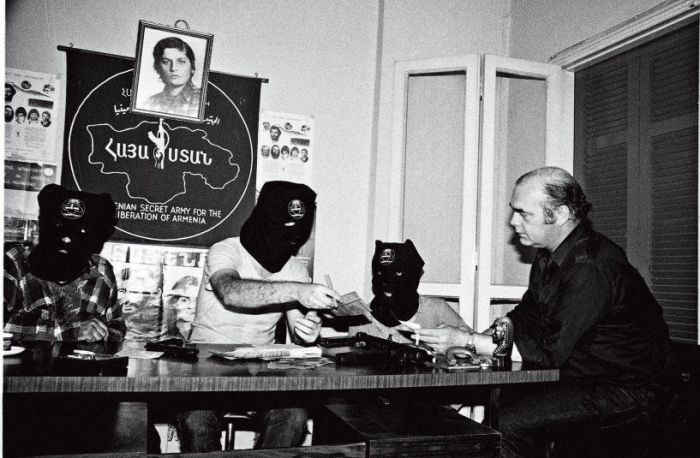by Mehreen Gul
Since the last three decades, terrorism has been increasingly causing lethal and detrimental consequences for the world in this modern era; it had become a threat to global security order. Although the prevailing discourse has seen the rise of rampant terrorism since the 9/11 attacks, there are other enormous examples of such attacks and terror activities conducted by Armenian terrorists around the 19th and 20th centuries to kill innocent civilians for their geopolitical objectives.
The Armenians terrorist groups, backed by state-political and military factions, have used terrorism as a striking tool to maintain their national interests on the cost of killing hundreds of innocent people. The violence and political objectives remained the substantial reasons behind Armenian terrorism. More specifically, in the South Caucasian region, the Armenian state-sponsored terrorist groups targeted thousands of Azeris and other ethnic groups on the name of extremist ethos, sectarianism, violence, xenophobia, and discrimination. The Armenian terrorism is explicitly exclusive because the whole Armenian community supports such kind of terrorist acts to get revenge from neighbouring countries like Azerbaijan and Turkey. One of the significant reasons behind legalizing terrorism at the state-level is to consolidate the Armenian ethnicity and to counter the perceived enemies, whether it’s Azerbaijan or Turkey.
There are several state-sponsored political and terrorist organizations in Armenia including; Armenian Party, Hanchak Party, The Dashnaksyutun Armenian Federative Revolution Party (ARFD), The Armenian Secret Liberation Army (ASOA), The Armenian Secret Army for Liberty of Armenia (ASALA), The Geqaron, Armenian Liberation Front and many more; even the list of these terrorist organizations couldn’t end at a specific point. Similarly, the Armenian Republic has consistently supported terrorism at the state level and turned it into a state’s national policies to finance terror acts against Azerbaijan civilians and government officials. In addition to this, the Armenian officials launched a campaign to give financial support and shelter them; several terrorists who were involved in major terror attacks across the world, sentenced by European courts for life-imprisonment, also took shelter in Armenia.
Primarily, the history of Armenian terrorism traced back into the Ottoman Empire, when ARFD, a terrorist organization, attacked Central Bank in Istanbul, taking around 160 civilians hostages. ARFD forced the Ottomans to give a peculiar representation to Armenians in Ottoman Parliament, and they got succeeded; their efforts were to terrorize the regional actors to uplift and advance the Armenian nationalistic approach for regional dominance; no matter what the cost is. Regrettably, in the 19th and 20th century the Armenian terrorists got a significant edge by conducting a series of high-profile assassinations of Azerbaijan and Turkish officials. It’s remained a hysterical approach of Armenians to increase their visceral hatred against any community or ethnic group who stood against them; the prevailing literature doesn’t find such a fanatical mindset of any state like the Armenians. Since the 1980s, the Armenian terrorist organizations, under the financial and logistic supervision of the Armenian government, are operating in several countries around the world against Azerbaijanis to annihilate them systematically.
Keeping in view the Armenian aggression and terrorist activities at state-level, AFRD along with other terror wings had planned a vicious massacre against Azerbaijan in 1918, when the Azerbaijanis were celebrating “Novruz-national holiday” and AFRD have attacked them relentlessly by slaughtering thousands of Azerbaijanis, destroyed and screwed-up all targeted infrastructures. Moreover, “Operation Nemesis” was launched by Armenian terrorist organizations to seek vengeance against Turkey and Azerbaijan. These terrorist organizations like; ASALA, JCAG, and NAR, etc. operated around the world to assassinate the government’s officials, including diplomats and ministers. Taking into account prominent and noticeable evidence, in the 1970s the Armenians have carried out almost 240 terrorist attacks around Europe, the Middle East, and Asia by killing over 70 government officials of different states. Albeit, International legislative acts were proposed against Armenian terrorism, but the implementation remained ephemeral and fragile.
More specifically, Azerbaijan has remunerated a massive cost over the Nagorno-Karabakh issue. Armenian terrorist groups have always taken an aggressive stance considering this conflict as an ethnic and nationalistic issue; terror groups like ASALA and AFRD did nothing except attacking public places, schools, transport sites, and metro trains by killing hundreds of innocent Azeris civilians. The Armenian tactics for terror acts were mainly against children, women and aged Azeris nationals; explosive devices, sniper attacks, bombing, vehicle-based attacks, and suicide attacks were extensive terror strategies used against these targeted countries. Since the independence, Armenia justified these terror acts as legal to advance their illegal territorial claim over Nagorno-Karabakh and seven other adjacent regions of Baku. Whosoever got turned against the Armenian position at the regional or international level, Armenia financed the terror groups to wipe them off; that’s how Armenian national and foreign policy works. In addition to the Nagorno-Karabakh conflict, in 1992 Khojaly massacre was another tragic example of Armenian regional terrorism, in which approximately 650 Azerbaijan civilians were brutally persecuted and killed by Armenian sponsored terrorist organization. Even the Presidents of Armenia were called as warlords and assailants for supervising the terror attacks at state and international scale; Serzh Sargsyan, a former President of Armenia, publicly confessed about Khojaly massacre but who would interrogate them for these heinous and atrocious activities? That’s a severe concern for regional states and the international community.
Consequently, the terror hysteria and fanatic nationalistic sentiments of Armenia are continued to achieve their geopolitical interests, and it’s posing a serious threat to regional peace and stability. It would do nothing except the deterioration of regional tranquillity, and the regional states would keep facing security dilemmas. In short, to ensure peace, security order, and stability at the regional and international levels, the joint efforts should be exerted to vanquish terror and violence-based extreme Armenian nationalism. Otherwise, it would keep threatening regional security and peace.
Mehreen Gul is a Director, Center for Global & Strategic Studies (CGSS), Islamabad & Eurasian Expert.
More about: Armenia
















































